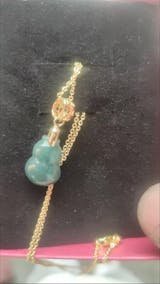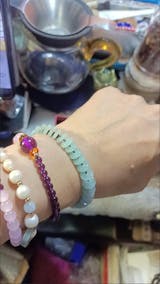Dzi Beads: Timeless Treasures from the Heavens
Introduction
Dzi beads, hailed as heavenly treasures, are considered among the most valuable jewels in the world. In Tibetan culture, they have long been revered as heirlooms, historically used to trade for precious commodities like horses and livestock. Tibetans believe that Dzi beads not only hold immense monetary value but also possess mystical protective powers. Today, their allure has captured the hearts of many celebrities, who often wear them to events. This admiration stems not only from their striking appearance but also from their profound cultural significance.

The Symbolism and Protective Powers of Dzi Beads
Dzi beads symbolize beauty and nobility. In Tibetan culture, they hold an irreplaceable status, believed to protect the wearer from misfortune. These beliefs are deeply rooted in tradition and personal stories. For instance, martial arts star Jet Li developed a deep connection with Dzi beads after recovering from an illness in Tibet, treating them as a protective talisman.
Regarding the rare Nine-Eyed Dzi bead, collector Ma Weidu noted that only two exist in the world—one embedded in a statue of Buddha Shakyamuni, and the other treasured by Jet Li.
Religious Significance of Dzi Beads
The religious importance of Dzi beads is undeniable. The patterns on these beads are closely tied to the Four Tantric Activities in Buddhism: pacifying, increasing, magnetizing, and subjugating. As such, they are considered sacred Buddhist treasures. Seventeenth-century Buddhist texts describe the Nine-Eyed Dzi bead and the Dallow Dzi bead as protective amulets.
In Tibetan mythology, Dzi beads also hold a prominent place. For example, in the epic of King Gesar of Ling, Dzi beads were presented as precious tributes by the kingdom of Azha, used to honor the Three Jewels, guardian deities, warriors, and civilians, symbolizing wealth and protection.
During Tibetan Buddhist fire rituals, high monks place Dzi beads with specific symbolic meanings into mandalas for blessings. After being blessed, the beads become more vibrant in color and intricate in pattern, enhancing their spiritual and protective power. This ceremony endows Dzi beads with profound spiritual energy, further elevating their value.

Material and Craftsmanship of Dzi Beads
The Tibetan-Chinese Dictionary defines Dzi beads as agate, cat's eye, or certain gemstones with medicinal properties. Most Dzi beads are crafted from etched agate using intricate inlay techniques, with materials primarily comprising agate or chalcedony.
Modern Dzi beads come in over ten varieties, including Nine-Eyed Dzi, Three-Eyed Dzi, and Lotus Dzi, each featuring unique patterns with distinct meanings. The etching process not only enhances their aesthetic appeal but also establishes them as symbols of faith and culture.
Why Wear Dzi Beads?
Wearing Dzi beads is believed to absorb negative energy and harmonize the body’s energy field. Tibetans traditionally wear them in the vulnerable area between the throat and chest to ward off evil spirits.
From a scientific perspective, the magnetic field of Dzi beads is said to positively affect the body, aiding in physical regulation. Their magnetic field is described as three times stronger than that of crystals, boosting vitality.
However, the appeal of Dzi beads goes beyond their protective qualities. Their unique design, rich history, and cultural heritage make them highly sought after for research and collection. As the saying goes, "One must experience it to truly understand its allure."

Cultural Value of Dzi Beads
Dzi beads embody not only supernatural protection but also tangible expressions of spiritual faith, captivating with their profound cultural symbolism. From their black base to white geometric patterns, Dzi beads display an artistic balance of order and rhythm.
As products of cultural fusion, Dzi beads integrate influences from Indian, Iranian, Central Asian, and Chinese civilizations. While their artistic features have evolved over time, their intrinsic essence remains unchanged. This consistency has made Dzi beads unique cultural artifacts beloved by many.
Three Tips for Choosing Genuine Antique Dzi Beads
1. Examine the Patina
Authentic antique Dzi beads develop a natural patina over time, exuding a soft, lustrous glow that contrasts with the brash tones of newer creations.
2. Look for Weathering Patterns
Antique Dzi beads exhibit distinctive ring-shaped weathering patterns, formed through prolonged exposure to environmental changes and wear. These patterns, resembling fish scales or bird claws, vary in depth.
3. Assess the Craftsmanship
Genuine Dzi beads showcase intricate etching with deep, sharp patterns, unlike the shallow surface carvings of imitations.

Conclusion
Dzi beads, with their unparalleled cultural value and spiritual significance, have captivated countless enthusiasts. Whether as talismans, ornaments, or key elements in religious rituals, they continue to shine with irreplaceable charm. Wearing Dzi beads is not just about aesthetics but also about embracing faith and tradition.
Related articles:
The Journey of Dzi Beads: History, Craftsmanship, and Quality Identification



























































